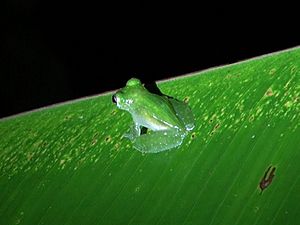Hyalinobatrachium valerioi facts for kids
Quick facts for kids Hyalinobatrachium valerioi |
|
|---|---|
 |
|
| Conservation status | |
| Scientific classification | |
| Synonyms | |
|
Centrolene valerioi Dunn, 1931 |
Hyalinobatrachium valerioi, also known as the La Palma glass frog, is a special kind of frog. It belongs to the Centrolenidae family, known for their see-through skin! You can find these tiny frogs in places like central Costa Rica, Panama, and parts of western Colombia and Ecuador.
Description
La Palma glass frogs are quite small. Male frogs grow to about 24 millimeters (less than an inch) long. Female frogs are a little bigger, reaching about 26 millimeters.
Their back, called the dorsum, is yellow with green lines that look like a net. Sometimes, you might see small dark spots in the green areas. Their belly is clear, so you can see some of their insides! However, their heart is covered by white tissue, so you can't see it. Their liver and digestive system are also white. These frogs have beautiful gold-colored eyes.
Hyalinobatrachium valerioi glass frogs are carnivores, which means they eat meat. Their main diet includes small insects. They enjoy munching on crickets, moths, flies, and spiders. Sometimes, they even eat other smaller frogs.
Reproduction and Life Cycle
Female glass frogs lay their eggs on the underside of leaves. These leaves are usually hanging over streams. Each group of eggs, called a clutch, has no more than 40 eggs.
What's special about these frogs is how the fathers care for their eggs. Unlike most other glass frogs, the male La Palma glass frog stays with its eggs all day and all night. This means they watch over their eggs for 24 hours a day until they hatch!
Habitat and Conservation
The La Palma glass frog lives in wet forests. These can be either old, untouched forests or forests that have grown back. Adult frogs usually live in bushes and trees that are found along forest streams.
These frogs can handle some changes to their home. They can still live in an area even if some of the forest is changed. But it's very important that the plants and trees over the streams stay there.
The number of La Palma glass frogs is going down in some places. However, in other areas, their population is stable. A big problem for them is habitat loss, which means their forest homes are being cut down. Pollution from certain farming activities can also harm them.
See also
 In Spanish: Hyalinobatrachium valerioi para niños
In Spanish: Hyalinobatrachium valerioi para niños


